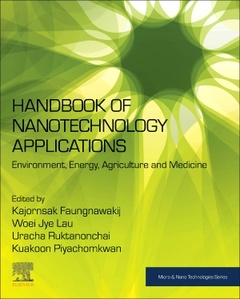Handbook of Nanotechnology Applications Environment, Energy, Agriculture and Medicine Micro and Nano Technologies Series
Coordonnateurs : Faungnawakij Kajornsak, Lau Woei Jye, Ruktanonchai Uracha Rungsardthong, Piyachomkwan Kuakoon

I- Enviroment
1 Nanostructured microporous membranes for advanced water and wastewater treatment
2 Recent advances on TiO2 photocatalysis for wastewater degradation: fundamentals, commercial TiO2 materials, and photocatalytic reactors
3 Nanomaterial development and its applications for emerging pollutant removal in water
4 Nanofiltration membranes for challenging environment
5 Recent progress of polyamide thin film nanocomposite membranes for water applications
6 Integrated nanofiltration membrane process for water and wastewater treatment
7 Photoelectrochemical processes for energy applications
8 Development of mixed matrix membranes for gas separations
II- Energy
9 Nanocatalysts for interconversion of CO2 to fuels and chemicals
10 Nanocomposite catalytic membranes for energy production: advances and challenges
11 Advances in nanocatalysts for aviation biofuels
12 Adhesive binders for nanosilicon anodes in lithium-ion batteries
13 Nanotechnology for hydrogen storage14 Safety of nanomaterials for energy applications
III- Agriculture
15 Nanoencapsulation in agricultural applications
16 Nanomaterials in agricultural and food applications
17 Nanotechnology in functional and active food packaging
18 Nanopore sequencing in agricultural and food applications
19 Novel applications of nanotechnology in food safety assessment
IV- Medicine
20 Nanocarrier-based vaccine delivery systems for synthetic peptide vaccines
21 Cancer nanomedicine
22 Bioprobe-conjugate polymeric micro/ nanoparticles as detection tools for infectious diseases
23 Inorganic nanoparticle-based biosensors for point-of-care diagnostics
24 Strategies for ligand-installed nanocarriers
25 Biomedical sensor
26 Predictive models for nanotoxicology: in vitro, in vivo, and computational models
27 Bioinspired nanostructures for tailoring mechanical properties
28 Three-dimensional printed scaffolds for tissue engineering
Index
Dr. Woei Jye Lau is currently an associate professor in the School of Chemical and Energy Engineering, at the Universiti Teknologi Malaysia (UTM). Dr Lau has a very strong research interest in the field of membrane science and technology for water applications and has published
>250 scientific papers with total number of Scopus citations exceeding 10,000. He is the author of the book Nanofiltration Membranes: Synthesis, Characterization and Applications published by CRC Press in 2017 and has edited several books published by CRC Press and Elsevier. Currently, Dr Lau serves as a subject editor for Chemical Engineering Research and Design (Elsevier) and is associate editor for Water Reuse (International Water Association).
In recognition of his research excellence, Dr Lau received the Australian Endeavour Research Fellowship in 2015, UI-RESOLV Program 2016 (Indonesia), Mevlana International Exchange Program 2017/2018 (Turkey), Sakura Exchange Program 2018 (Japan), TÜBITAK’s Fellowships for Visiting Scientists 2018 (Turkey), ASEAN-India Collaborative R&D Scheme 2019 and the 6th Science & Technology Exchange Program (Iran).
Uracha Rungsardthong Ruktanonchai is Deputy Executive Director, National Nanotechnology Center (NANOTEC), Thailand. Her research focuses in the areas of lipid and polymeric nanoparticles, nano-encapsulation, and advance drug delivery system.
Kuakoon Piyachomkwan is Deputy Executive Director, National Center for Genetic Engineering and Biotechnology (BIOTEC), National Science and Technology Development Agency (NSTDA), Thailand. Her research focuses on nanotechnology in food applications.
- Helps scientists and researchers quickly learn and understand the key role of nanotechnology in important industrial applications
- Takes an interdisciplinary approach, demonstrating how nanotechnology is being used in a wide range of industry sectors
- Outlines the role nanotechnology plays in creating safer, cheaper and more energy-efficient projects and devices
Date de parution : 10-2020
Ouvrage de 796 p.
19x23.3 cm
Thèmes de Handbook of Nanotechnology Applications :
Mots-clés :
3D printing; Acquired immune deficiency syndrome; Active packaging; Adhesion; Agriculture; Antibodies; Aptamers; Artificial photosynthesis; Aviation biofuel; Binders; Bio-based nanoparticle; Bioinspired materials; Biojet fuel; Biomimetic; Bioprobe; Biosensors; CO2 hydrogenation; CO2 reduction; Carbon; Carbon nanotubes; Catalytic membranes; Challenges; Chemical hydrogen storage; Chemical sensors; Chlorine resistance; Chromatography; Colorimetric detector; Computational model; Conjugation; Cost analysis; Deoxygenation; Desalination; Detection; Diarrhea; Drug delivery; Dye-doped nanoparticles; Ecotoxicology; Electrocatalysis; Electrochemical detector; Electrophoresis; Fertilizers; Fluorescence detector; Food; Food analysis; Food safety; Fouling; Functional packaging; Gas separation; Gold; Graphene; Graphene nanomaterials; H2 production; Hierarchy of controls; Human exposure; Hybrid/integrated process; Hydrogen absorbing alloy; Hydrogen spillover; Hydrogen storage; In vitro model; In vivo model; Infectious disease; Inorganic nanoparticle; Inorganic nanoparticles; Lateral flow sensor; Ligands; Lignin nanoparticles; Liposome; Liposomes; Lithium-ion batteries; Magnetic; Malaria; Mathematical modeling; Mechanical properties; Membrane; Metal-organic framework; Methane; Methanol; Micelles; Microneedle; Microparticle; Microstructure; Mixed matrix membranes; Nanocarbon; Nanocarrier vaccines; Nanocarriers; Nanocatalyst; Nanocellulose; Nanocomposite; Nanoencapsulation; Nanofillers; Nanofiltration; Nanomaterial; Nanomaterials; Nanomedicine; Nanoneedle; Nanopackaging system; Nanoparticle; Nanoparticles; Nanopore; Nanoscale



